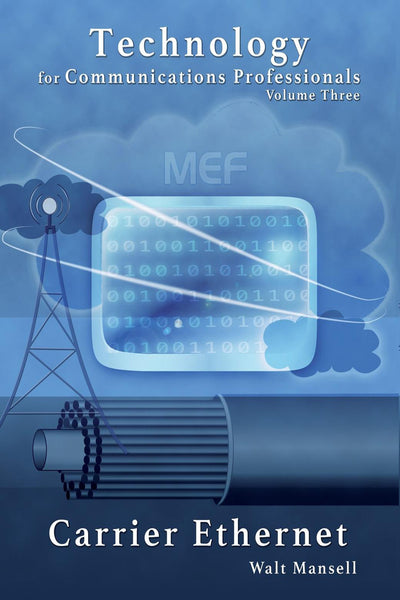Technology for Communications Professionals, Volume III: Carrier Ethernet
$69.95
Author: Walter Mansell
ISBN 978-1-62137-849-5 (hardcover)
ISBN 978-1-62137-850-1 (eBook)
536 Pages
CLICK HERE TO PREVIEW ON AMAZON
Ethernet, the LAN technology, is the universally accepted technology deployed on all public and private data networks. The migration from the legacy telecom and Cable TV networks is towards a single network capable of supporting all voice, video and data services over a single interface (wire). The service platform to support these services is Carrier Ethernet. The customer interface for the next generation network is Ethernet.
You could, in fact, consider Ethernet as the new dial-tone for the next generation network. Carrier Ethernet incorporates Ethernet LAN technology as the foundation to build the services platform. Carrier Ethernet provides the service provider with a ability to offer customers a range of granular services which can be uniquely tailored to the customer's requirements. In addition, Carrier Ethernet gives the service provider the means to control performance, provides a maintenance model, and defines the structure to enable accurate billing for such services. It's a big win for the customer as no new equipment is required to work with their existing LAN equipment.
For the service provider the Carrier Ethernet equipment is less expensive to purchase, deploy, and maintain. The last point to establish is that Carrier Ethernet is a collaborative technology. In many cases service providers may not have the network footprint to support all of their customers' locations. In such cases the service provider who "owns" the customer must rely on network operator partners to maintain the required customer service for their clients. All service providers and network operators should be on board and fully support Carrier Ethernet services and functions to participate in this market. All job functions within the service provider organization should understand the basic concepts and functions of Carrier Ethernet to apply their particular expertise and maximize the value they bring to the mission of the organization.
Technology for Communications Professionals is a three-volume set designed to provide the Communications Professional with a foundational knowledge of the technology used to enable communications on the public network. The intent of this series is to provide the fundamental concepts and functions upon which communications products and services will operate over the next several decades. The intervention of the Internet and packet-based networks has tipped the legacy telecom business on its head.
The next generation network transitions from a synchronous, big-system hardware-oriented network consisting of a complex core supporting simple end-user devices (telephone) to an asynchronous, software-oriented distributed processing network, simple core which relies on complex end-user devices (computer).
Related Items


Blue Pelican Java
$43.95
Author: Charles E. Cook ISBN 1-58939-758-4 (softcover) 544 Pages "Blue Pelican Java" is a somewhat unusual...


Cumulative Impact and Other Disruption Claims in Construction
$75.00
Authors: Richard J. Long, Rod C. Carter, and Harold E. Buddemeyer ISBN 978-1-62137-527-2 (hardcover) ISBN 978-1-62137-739-9...

Journey Toward Energy Independence
$25.95
Author: Harry Johnson ISBN 978-1-621-37987-4 (hardcover) 150 Pages BOOK DESCRIPTION For 150 years, conventional...






